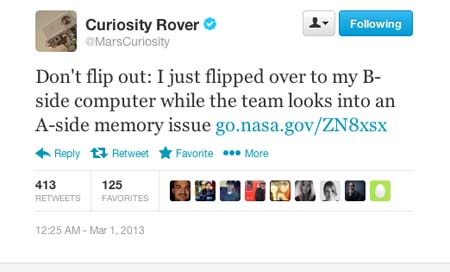Self-portrait of NASA's Mars rover Curiosity combines dozens of exposures taken by the rover's Mars Hand Lens Imager. The rover's robotic arm is not visible in the mosaic. Image via NASA
NASA’s Curiosity rover, which has been exploring Mars since last August, has halted its research following a malfunction last week when one of its two on-board computers experienced a memory glitch.
On Wednesday, NASA detected the glitch when Curiosity’s computer did not switch to the usual daily ‘sleep’ mode when planned.
The ground team for Curiosity switched the rover to a back-up on-board computer in response to a flash memory issue on the active computer.
NASA scientists carried out the computer swop on 28 February to put the rover into ‘safe mode’.
The computer error means the rover’s research on the Red Planet has been put on temporary hold, while its back-up computer is re-configured.
The scientists will be moving the rover from safe mode to operational status over the coming days.
“We switched computers to get to a standard state from which to begin restoring routine operations,” said Richard Cook of NASA’s Jet Propulsion Laboratory (JPL), which built and operates Curiosity.
Curiosity carries a pair of redundant main computers in order to have a back-up if one fails. Each of the computers – A-side and B-side – also has other redundant subsystems linked to that computer.
Curiosity is now operating on its B-side.
“While we are resuming operations on the B-side, we are also working to determine the best way to restore the A-side as a viable back-up,” said JPL engineer Magdy Bareh.

On Curiosity’s Twitter feed, NASA wrote: “Don’t flip out: I just flipped over to my B-side computer while the team looks into an A-side memory issue”.
Curiosity had recently started analysing rock samples it had collected from Mars after drilling into rock. The rover had ingested the first samples of rock powder ever collected from Mars and its lab instruments were starting to carry out experiments.
The Curiosity rover landed on Mars last August for a two-year mission to investigate whether the planet ever offered environmental conditions that could have supported microbial life.

An animated set of three images from NASA’s Curiosity rover shows the rover’s drill in action for the collection of rock samples in the Yellowknife Bay region of Gale Crater on Mars on 8 February 2013. Image via NASA